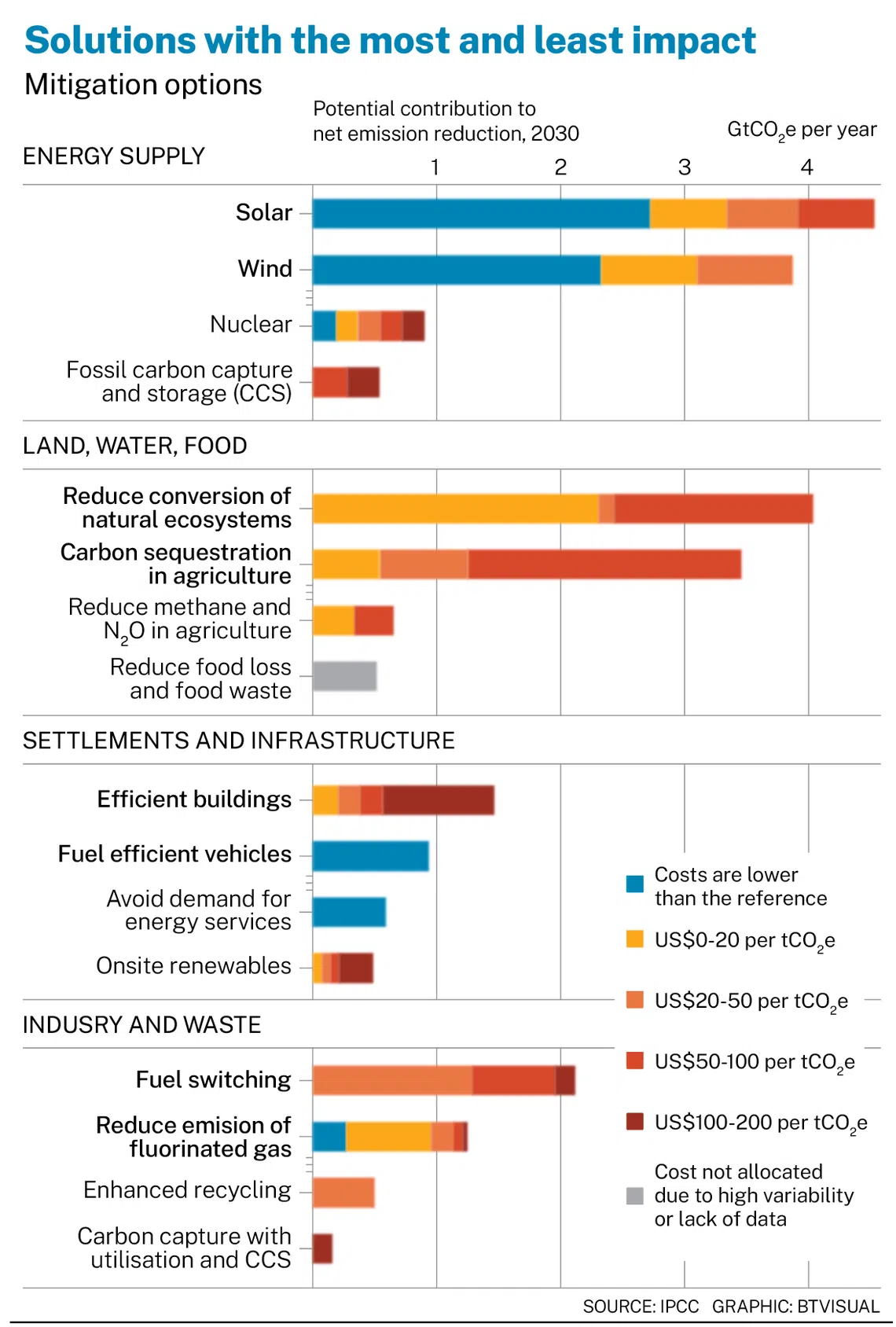Solutions ranked in UN’s ‘how-to guide to defuse the climate time-bomb’

Wong Pei Ting
COMPANIES acting on climate change had long been banking on technologies without a definitive guide as to how effective they are in the grand scheme of things. Now they do.
The United Nations’ (UN) latest drop on Monday (Mar 20), described as a “survival guide for humanity” and “how-to guide to defuse the climate time-bomb”, ranked solutions by how much each of them can contribute to the world’s net emissions reductions from now till 2030.
The Synthesis Report by the UN’s Intergovernmental Panel on Climate Change (IPCC) also carries the finding that the solution set currently at the world’s disposal to fix its climate change woes is more compelling than previously thought.
It lists plenty of options estimated to cost US$100 or less to cut back every tonne of carbon dioxide equivalent (tCO2e) in 2030. These solutions combined could reduce global emissions by at least half of the 2019 level by 2030, if acted upon now, it went on to state.
And while the IPCC report does not specifically reference carbon markets, it states more clearly than before that conservation management and forest restoration offered the largest share of economic mitigation potential.
These emerged as the top five most significant climate actions that can be taken in the near term to move the needle on global emissions. The other three are solar, wind and carbon sequestration in agriculture.
Of the five options, forest restoration, which is termed in the paper as “ecosystem restoration, afforestation and reforestation”, is estimated to be the most expensive, however.
The report reckoned about 22 per cent of the costs associated with such efforts could stretch into the US$100 to US$200 per tCO2e region, although close to half of the cost is estimated to be in the US$50 to US$100 region, with the rest costing under US$50.
The costs referred to in the report are net lifetime discounted monetary costs of avoided greenhouse gas emissions calculated relative to a reference technology.

In comparison, solar and wind harvesting – the two top energy supply-linked mitigation efforts – will largely cost lower than the reference. Wind would likely have peaked at between US$20 and US$50 per tCO2e, while solar’s peak could be higher, but under US$100.
IPCC’s chart, meanwhile, showed that nuclear and fossil carbon capture and storage are estimated to make the least impact under the energy supply piece.
Notably, fossil carbon capture and storage, which refers to the capture of emissions from fossil fuel burning, is thought of as only having the potential to cut back emissions by close to 0.5 giga-tCO2e a year, despite a price tag ranging from US$50 to US$200 per tCO2e.
A technology that is also as expensive but promising better results is bioelectricity, which depends on energy from biomass, or organic materials. It was assessed to have the potential to roll back emissions by more than one giga-tCO2e a year, similar to the impact a reliance on geothermal and hydropower would bring.
Meanwhile, strategies targeted at reducing methane emissions from fossil fuel operations are expected to drive down emissions by close to 1.5 giga-tCO2e a year. Their associated costs are expected to range widely, however, from lower than the reference to over US$200 per tCO2e.
Solutions that can be relied upon to cost lower than the reference are fuel-efficient vehicles, efficient lighting, appliances and equipment, public transport and bicycling, efficient shipping and aviation, and those helping to avoid demand for energy services.
These all come under the ambit of urban systems. The top solution in this category is the switch to “efficient” buildings. These, which would require design, construction and retrofit works, largely cost US$100 to US$200 to mitigate each tCO2e, the report stated.
On-site renewables are on the other end of the spectrum, with a potential to only contribute to net emissions reductions of about 0.5 giga-tCO2e a year in 2030, despite a requirement for relatively higher cost outlays.
The best solutions for industry and waste systems are fuel switching – expected to predominantly cost US$20 to US$50 per tCO2e to implement – and strategies to aid a reduction of fluorinated gas emissions, costing up to US$20 for the most part.
Solutions assessed to come with the lowest impacts under this category are carbon capture, utilisation and storage, enhanced recycling and construction materials substitution.
Nevertheless, despite each solution’s merits and pullbacks, UN Secretary-General Antonio Guterres said in a video message that climate action is needed on all fronts, “everything, everywhere, all at once”, in stark reference to this year’s Academy Award for Best Picture winner.
The UN chief also proposed to the G20 group of highly developed economies a “climate solidarity pact”, in which all big emitters would make extra efforts to cut emissions.
Under this, wealthier countries would be expected to mobilise financial and technical resources to support emerging economies in a common effort, to ensure that global temperatures do not rise by more than 1.5 degrees Celsius above pre-industrial levels.
So far, temperatures have already risen to 1.1 deg C above pre-industrial levels, a consequence of more than a century of burning fossil fuels as well as unequal and unsustainable energy and land use, according to the report.
Decoding Asia newsletter: your guide to navigating Asia in a new global order. Sign up here to get Decoding Asia newsletter. Delivered to your inbox. Free.
Copyright SPH Media. All rights reserved.




